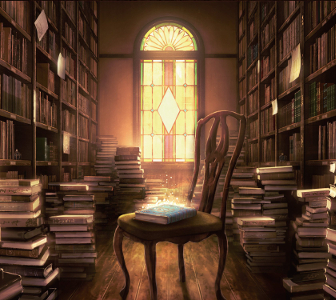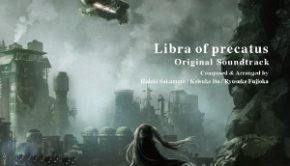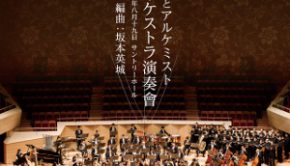Bungo and Alchemist Music Collection
 |
Album Title: Bungo and Alchemist Music Collection |
| Record Label: noisycroak Records |
|
| Catalog No.: NCRS-0018 |
|
| Release Date: May 31, 2017 |
|
| Purchase: Buy at Amazon Japan |
Overview
The Bungo and Alchemist Music Collection is the soundtrack release for the PC online card battle game, Bungo to Alchemist. Composed by Hideki Sakamoto and featuring live musicians, how does this overall effort turn out?
Body
The album opens with the titular track, “Bungo to Alchemist,” a sweeping ensemble piece with a strong focus on strings, piano, and woodwinds. It has a very Gust-like sound, perhaps partially inspired by the alchemy based Atelier series, but with a Sakamoto touch. The piece is bright, engaging, and features a beautiful melody that really shines. “Ikoi” is a very poignant piano and woodwind driven piece with a delicate sound that complements the melody quite nicely and makes for a calming listen. On the other hand, romance is in the air with “Wa,” a woodwind driven piece with pizzicato strings that boasts a decent melody and has a romantic air about it. A French air surrounds “Iza Sei Kime Yamo” with its strings and accordion focus. The strings are definitely more of an action driver for the piece, but the melody itself isn’t terribly strong and the strings do feel a bit stale as the piece goes on. “Mawari Mi” also has a French sound to its melody with accordion and harpsichord creating a jovial piece while the violin introduces a hint of romance. A bright and bubbly affair, “Secchuu Shokudou” offers a woodwind and strings focused piece with staccato piano chords to create a lighthearted piece that is reminiscent of a town theme in an RPG. “Kanchou no o Daikyoku” is a militaristic march with a style reminiscent, at times, of Joe Hisaishi, but the end result is a melody that isn’t terribly engaging and overall is very pedestrian and boring.
“Shoku Mini Kou Fu Bunshi Tare” conjures up images of Kingdom Hearts with its pounding piano chords and rhythm. The strings focused battle tune with woodwind accents certainly creates a lot of energy and the violin helps pierce through the tension. It’s a decent battle tune, but one that does sound a bit uninspired. Another action oriented piece, “Hatan Suru Ha Kuruma” is a very tense and dramatic piece focusing, once again, on strings and piano. It has an ominous presence about it, although with moments lacking said tone, but the end result suffers from repetition. “Michi to Michi Iku Bunshi Tare” is another action oriented piece with a militaristic sound with a Hamauzu-esque approach. The overall soundscape is pleasant and the woodwind melody certainly helps to carry the piece. “Shoubi ni Kou Fu Bunshi Tare” has a more romantic sound to the strings melody component of the piece with a very classically oriented piano accompanying it. When the melody is in the fore, the piece is quite exciting, but when the tune focuses more on tension building, it becomes a bit less interesting. Last of the action oriented tunes is “Kaishin Tome Menu Bunshi Tare,” a strings-led piece that sounds like a more action oriented echochrome piece mixed with a Gust pastiche sound that adds some elements of heroism into the tune.
There are also four bonus tracks on the album, two of which belong to “Bungo to Alchemist.” The first is “Bungo to Alchemist ~Piano ver.~,” an upbeat piano rendition that helps retain the overall nature of the original, but suffers a bit due to the lack of other instruments that truly helped elevate the original. The other is “Bungo to Alchemist ~Orchestra ver.~” that offers a more romantic and softer approach compared to the original, yet retains the feel of the original, but with a more varied instrument lineup. “Ikoi ~Strings ver.~” drops the woodwinds entirely focusing more on an ensemble approach with the piano that definitely gives it a more romantic atmosphere with a tune that is equally as enjoyable as the original. Lastly, “Hatan Suru Ha Kuruma ~Orchestra ver.~” certainly benefits from a lusher sound, including some choral notes, but the inherent repetition of the piece does it no favors compared to the original.
Summary
In the end, Bungo and Alchemist Music Collection certainly isn’t Hideki Sakamoto’s strongest efforts. The more lighthearted pieces are the stronger of the two major components on the soundtrack, providing a sound reminiscent of Gust’s Atelier series, while the action oriented pieces feature a blend of styles that feel like an amalgamation of a variety of different composer styles. The bonus tracks are generally strong and help serve as a nice addition to the soundtrack. Fans of the music heard in game or even the samples on the website might want to check this out.
Do you agree with the review and score? Let us know in the comments below!
3.5
Posted on October 20, 2017 by Don Kotowski. Last modified on October 19, 2017.














